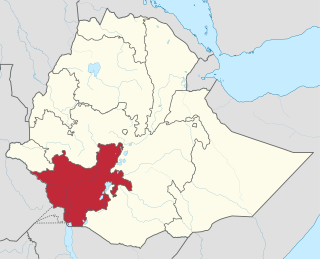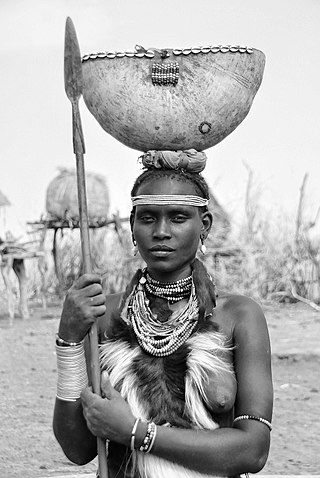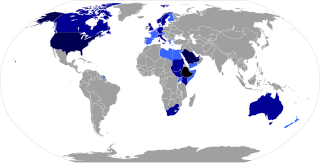
The Cushitic languages are a branch of the Afroasiatic language family. They are spoken primarily in the Horn of Africa, with minorities speaking Cushitic languages to the north in Egypt and Sudan, and to the south in Kenya and Tanzania. As of 2012, the Cushitic languages with over one million speakers were Oromo, Somali, Beja, Afar, Hadiyya, Kambaata, and Sidama.

The Omotic languages are a group of languages spoken in southwestern Ethiopia, in the Omo River region and southeastern Sudan in Blue Nile State. The Geʽez script is used to write some of the Omotic languages, the Latin script for some others. They are fairly agglutinative and have complex tonal systems. The languages have around 7.9 million speakers. The group is generally classified as belonging to the Afroasiatic language family, but this is disputed by some.

The Southern Nations, Nationalities, and Peoples' Region was a regional state in southwestern Ethiopia. It was formed from the merger of five kililoch, called Regions 7 to 11, following the regional council elections on 21 June 1992. Its government was based in Hawassa.
Lowland East Cushitic is a group of roughly two dozen diverse languages of the Cushitic branch of the Afro-Asiatic family. Its largest representatives are Oromo and Somali.

The Mursi are a Surmic ethnic group in Ethiopia. They principally reside in the Debub Omo Zone of the Southern Nations, Nationalities, and People's Region, close to the border with South Sudan. According to the 2007 national census, there are 11,500 Mursi, 848 of whom live in urban areas; of the total number, 92.25% live in the Southern Nations, Nationalities, and People's Region (SNNPR).

The Hamar people are a community inhabiting southwestern Ethiopia. They live in Hamer woreda, a fertile part of the Omo River valley, in the Debub Omo Zone of the former South Ethiopia Regional State (SERS). They are largely pastoralists, so their culture places a high value on cattle.

The languages of Ethiopia include the official languages of Ethiopia, its national and regional languages, and a large number of minority languages, as well as foreign languages.

The Daasanach are an ethnic group inhabiting parts of Ethiopia, Kenya, and South Sudan. Their main homeland is in the Debub Omo Zone of the Southern Nations, Nationalities, and People's Region, adjacent to Lake Turkana. According to the 2007 national census, they number 48,067 people, of whom 1,481 are urban dwellers.

Ethiopians are the native inhabitants of Ethiopia, as well as the global diaspora of Ethiopia. Ethiopians constitute several component ethnic groups, many of which are closely related to ethnic groups in neighboring Eritrea and other parts of the Horn of Africa.

The Welayta, Wolayta or Wolaytto are an ethnic group and its former kingdom, located in southern Ethiopia. According to the most recent estimate (2017), the people of Wolayta numbered 5.83 million in Welayta Zone. The language of the Wolayta people, similarly called Wolaytta, belongs to the Omotic branch of the Afro-Asiatic language family. Despite their small population, Wolayta people have widely influenced national music, dance and cuisine in Ethiopia.
Hamer or Hamer-Banna is a language within the South Omotic branch of the Afroasiatic language family. It is spoken primarily in southern Ethiopia by the Hamar people, Banna people, and by speakers of Karo.
The Yem are an ethnic group living in south-western Ethiopia. Their native language is Yemsa, one of the Omotic languages, although many also speak Amharic. The neighbors of the Yem include the Gurage, Hadya, and Kembata to the east across the Omo River and the Jimma Oromo to the south, north and west.

Karo is a South Omotic language spoken in the Debub (South) Omo Zone of the Southern Nations, Nationalities, and People's Region in Ethiopia. Karo is described as being closely related to its neighbor, Hamer-Banna, with a lexical similarity of 81%, and is considered a dialect of Hamer by Blench (2006), but as a separate language belonging to the Hamer-Karo subfamily in Glottolog. The Karo people, who live close to the lower Omo River, use colorful bodywork, complex headdresses and body scars to express beauty and importance within the community. 2,400 speakers are using the Karo language.
The Aroid or Ari-Banna languages possibly belong to the Afro-Asiatic family and are spoken in Ethiopia.
Hozo is an Afroasiatic language spoken mostly in the Kondala woreda of Mirab Welega Zone by peoples generically known as "Mao". There are smaller groups of Hozo speakers in Mana Sibu woreda. The term Hozo is usually understood by the Mao to refer to a clan. Hozo speakers prefer to call themselves Amo. Hozo and Seze are sometimes called Begi Mao. Hozo is spoken by roughly 3,000 people in Ethiopia. Hozo is also a clan in the Begi area. The Hozo language is also known as Begi-Mao and Mao of Begi. Its classification is Afro-Asiatic, Omotic, and Mao. The word Mao is Omotic and means ‘man; people’, occurring as [ma:ɪ] in Seze and as [mɔ:] in Hozo. Mao is frequently used as an ethnic term. There is a kind of Mao identity across language differences in Ethiopia. While it is generally accepted today that Omotic is one of the primary branches of the Afro-Asiatic family, the position of the four languages Hozo, Seze, Ganza and Northern Mao is still being discussed. The Mao languages are the least documented within Omotic, and Omotic itself is the least documented of the Afroasiatic groups.

The Konso, also known as the Xonsita, are a Lowland East Cushitic-speaking ethnic group primarily inhabiting south-western Ethiopia.
Mingi is the traditional belief among the South Omotic-speaking Karo and Hamar peoples of southern Ethiopia that children with perceived and true physical abnormalities are ritually impure. An example of perceived abnormalities include the top teeth erupting before bottom teeth. Children born out of wedlock (marriage) are also considered impure and therefore capable of bringing curses upon the people.

The Kwegu are an ethnic group that lives on the western banks of the Omo River in the newly formed South Ethiopia Region. Some members of the Kwegu also live on the eastern banks of the river among the Mursi. Previously they were hunter-gatherers, but today they are engaged in a mixed economy of hunting, farming, beekeeping, and fishing.
Goffa or Gofa are an Omotic ethnic group indigenous to Omo Valley located in Ethiopia's Southern Nations, Nationalities, and Peoples' Region. According to 2007 census there are 363,009 ethnic Goffa in Ethiopia, which make up around 0.49% of the country's total population. Traditional language of the Goffa is the Goffa language, which belongs to the Omotic branch of the Afroasiatic languages.

Ethiopia is considered the area from which anatomically modern humans emerged. Archeological discoveries in the country's sites have garnered specific fossil evidence of early human succession, including the hominins Australopithecus afarensis and Ardipithecus ramidus. Human settlements in present-day Ethiopia began at least in the Late Stone Age, and the agricultural revolution took place in the third millennium BCE. Ethnolinguistic groups of Afroasiatic speakers and Nilo-Saharan speakers—defined by new ethnic, cultural, and linguistic identities—emerged around 2000–1000 BCE.














